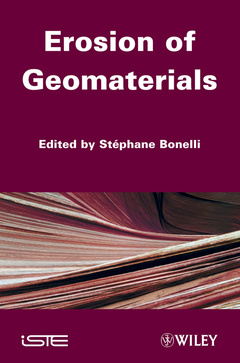Erosion of Geomaterials
Coordonnateur : Bonelli Stephane

This book aims to deliver significant scientific progress on the problem of the erosion of geomaterials, focusing on the mechanical/physical aspect. The chapters oscillate between a phenomenological outlook that is well grounded in experiments, and an approach that can offer a modeling framework.
The basic mechanisms of internal and surface erosion are tackled one-by-one: filtration, suffusion, contact erosion, concentrated leak erosion, sediment and wind transport, bedload transport. These erosion mechanisms comprise both hydraulic structures (dams, dikes) and natural environments (wind, river, coastal).
In this book, physicists and mechanicians share with the reader their most recent findings in their field work and study, while at the same time maintaining an accessible format. This compendium provides a well-documented information resource, and above all, a tool for approaching the issue of erosion of geomaterials in an up-to-date fashion for students, researchers and practitioners alike.
Foreword xiii
Paul ROYET
Introduction xv
Stéphane BONELLI
Chapter 1. Introduction to the Process of Internal Erosion in Hydraulic Structures: Embankment Dams and Dikes 1
Jacques FRY
1.1. Introduction 1
1.2. The significance of internal erosion for hydraulic structures 2
1.3. The impact of incidents on embankment dams and dikes 5
1.4. Main results of erosion trials 16
1.5. Remarks on the applicability of erosion trials 24
1.6. Conclusion 35
1.7. Bibliography 36
Chapter 2. Suffusion, Transport and Filtration of Fine Particles in Granular Soil 39
Didier MAROT and Ahmed BENAMAR
2.1. Introduction 39
2.2. Dominant parameters that influence suffusion 41
2.3. Main initiation criteria for suffusion 45
2.4. An initiation criterion formulated using a geohydromechanical approach 53
2.5. The scaling effect and the energetic approach 55
2.6. Coupling the phenomena of suffusion and filtration-clogging 58
2.7. Processes causing filtration 59
2.8. Filtration modeling 64
2.9. Confrontation between the laboratory filtration tests and the modeling 69
2.10. Filtration and clogging 71
2.11. Conclusion 74
2.12. Bibliography 75
Chapter 3. The Process of Filtration in Granular Materials 81
Eric VINCENS, Nadège REBOUL and Bernard CAMBOU
3.1. Introduction 81
3.2. Fundamental characteristics of the filtering granular media 82
3.3. The distribution of constriction size 84
3.4. A probabilistic approach of constriction sizes 92
3.5. Diameter of control constrictions 99
3.6. A continuous approach of the process of filtration 105
3.7. Conclusion 110
3.8. Bibliography 111
Chapter 4. Contact Erosion between Two Soils 115
Rémi BÉGUIN, Pierre PHILIPPE, Yves-Henri FAURE and Cyril GUIDOUX
4.1. Introduction 115
4.2. Areas prone to CE in hydraulic structures 116
4.3. Description of CE mechanisms on a local scale 120
4.4. CE of a fine soil under a coarse soil 131
4.5. CE of a fine soil on a coarse soil 146
4.6. Possible scenarios that may lead to failure of a hydraulic structure 149
4.7. Conclusion and perspectives 151
4.8. Bibliography 152
Chapter 5. Concentrated Leak Erosion 155
Nadia BENAHMED, Christophe CHEVALIER and Stéphane BONELLI
5.1. Introduction 155
5.2. General points 156
5.3. The device and the protocol of the HET 160
5.4. Methods of interpretation 164
5.5. Effect of different soil parameters on erosion 174
5.6. Importance of the erosion index for hydraulic structures 181
5.7. Conclusion 183
5.8. Bibliography 184
Chapter 6. Modeling of Interfacial Erosion 187
Stéphane BONELLI, Frédéric GOLAY and Fabienne MERCIER
6.1. Introduction 187
6.2. Modeling of a two-phase medium 189
6.3. Modeling of the soil/fluid interface 195
6.4. Modeling of flow with erosion 198
6.5. Numerical modeling 205
6.6. Validation of numerical models 209
6.7. Illustrative examples 213
6.8. Conclusion 219
6.9. Bibliography 219
Chapter 7. Physics of Sediment and Aeolian Transport 223
Bruno ANDREOTTI and Philippe CLAUDIN
7.1. Introduction 223
7.2. Static transport threshold 224
7.3. Aeolian transport 227
7.4. Quantitative description of transport 232
7.5. Linear stability analysis of a flat erodible bed 240
7.6. Conclusion 248
7.7. Acknowledgments 249
7.8. Bibliography 249
Chapter 8. Two-Phase Modeling of Bedload Transport 253
Pascale AUSSILLOUS, Elisabeth GUAZZELLI and Yannick PEYSSON
8.1. Introduction 253
8.2. Incipient motion 254
8.3. Bedload transport 265
8.4. Conclusion and outlook 276
8.5. Acknowledgments 276
8.6. Bibliography 277
Chapter 9. Characterization of Natural Cohesive Sediments and Water Quality of Rivers 281
Fabien TERNAT, Patrick BOYER, Fabien ANSELMET and Muriel AMIELH
9.1. Introduction 281
9.2. Behavior of pollutants in rivers 282
9.3. Erosion of fine cohesive sediments 292
9.4. Experimental characterization 302
9.5. Example of operational application 310
9.6. Conclusion 317
9.7. Bibliography 319
Chapter 10. Sediment Transport and Morphodynamics in Nearshore Areas 325
Vincent REY and Damien SOUS
10.1. Introduction 325
10.2. Marine sediments 326
10.3. Sediment transport 331
10.4. Sediment structures and morphodynamic structures 336
10.5. Local effects: scouring around the structures 351
10.6. Long-term morphodynamics of beaches 354
10.7. Conclusion 359
10.8. Bibliography 360
List of Authors 365
Index 369
Stéphane Bonelli is a Research Professor at the French Environmental Sciences and Technologies Research Institute (Cemagref). He graduated in Civil Engineering in 1988, obtained his PhD in Geomechanics in 1993 and holds a Habilitation from Marseille University. He created the Geomechanics and Erosion team in 2002 (12 people). He has over 20 years of teaching and research experience, and has published more than 60 papers on various aspects of numerical modelling of earthdams, internal erosion and monitoring data analysis. He has been a member of FrCOLD (French Committee on Large Dams) since 1998. He has been a member of the ICOLD (International Commission on Large Dams) European Working Group on Internal Erosion since 2005. He participated to 19 large dams reviews in Fance (visual inspection, monitoring data analysis and numerical modeling). Current activities include research, teaching and consultancy, focussing on soil erosion and the processes of levee breach.
Date de parution : 08-2012
Ouvrage de 372 p.
16.3x24.1 cm
